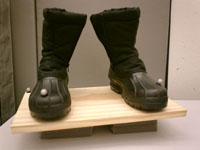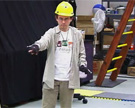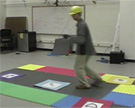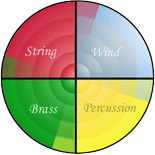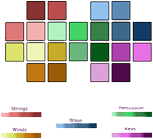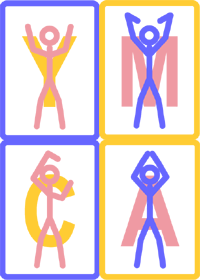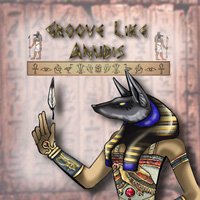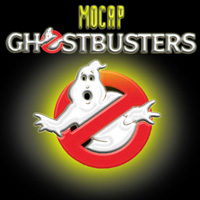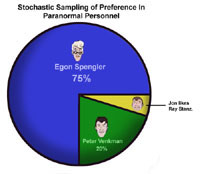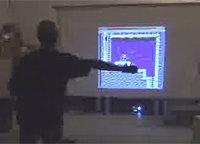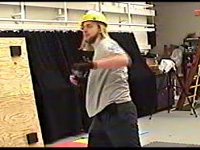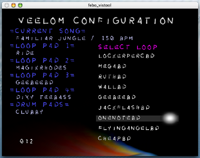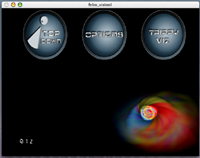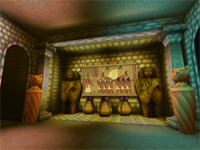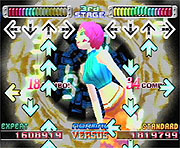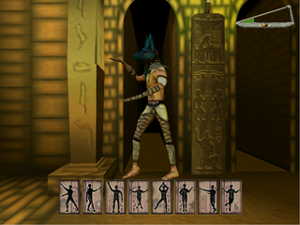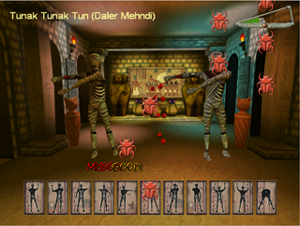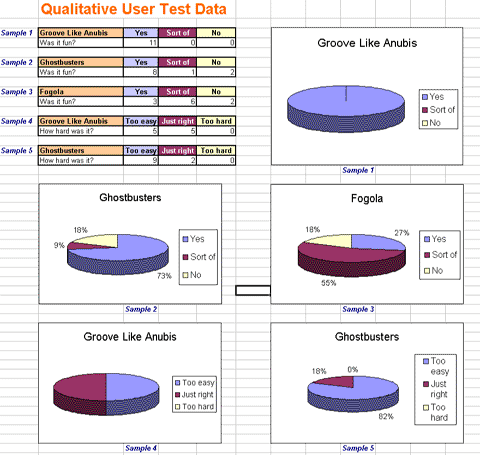| [
icehopper ] [ body cursor
] [ fogala ] [ YMCA
] [ DDA ] [ ghostbusters ]
[ EMU ] [ VEELOM ] [ DDA 2 ] |
|||||||
|
|
|||||||
| ICEHOPPER | |||||||
|
Icehopper is a simple game where the guest must jump and land on a green tile without touching the area in any of the other tiles. Initially the prototype was HMD, 1st-person based, but it was quickly discovered that a 3rd-person view was much easier. A simple themed environment and sound effects were added in the second iteration, along with a physical hopping device, VERTO. Duration:
2 weeks, 1 full-time dev
|
|
||||||
| [
icehopper ] [ body cursor
] [ fogala ] [ YMCA
] [ DDA ] [ ghostbusters ]
[ EMU ] [ VEELOM ] [ DDA 2 ] |
|||||||
|
|
|||||||
| BODY CURSOR | |||||||
|
The body cursor tests simple raycasting in 3D space and appendage torquing. The guest controls a virtual hand and reticle to point at a ring of icons. When an icon experiences the 3D equivalent of a mouseover event, the center of the ring lights up with the selected icon. The ring of icons may be rotated by a subtle twisting of the wrist. Duration:
2 weeks, 1 part-time dev
|
|
||||||
| [
icehopper ] [ body cursor
] [ fogala ] [ YMCA
] [ DDA ] [ ghostbusters ]
[ EMU ] [ VEELOM ] [ DDA 2 ] |
|||||||
|
|
|||||||
| FOGALA (MUSICAL INSTRUMENT) | |||||||
|
The Fogala is an experiment to generate original music via 3D body movement. Different timbres are selected by 2D movement on the ground plane (encoded by tracked, reconfigurable, laminated floor tiles) and note volume/chord progression are tracked by extension of the arms over the set of 3D planes. Duration:
4 weeks, 1 part-time dev
Fogala.
(click images for video) |
|
||||||
| [
icehopper ] [ body cursor
] [ fogala ] [ YMCA
] [ DDA ] [ ghostbusters ]
[ EMU ] [ VEELOM ] [ DDA 2 ] |
|||||||
|
|
|||||||
| YMCA | |||||||
|
YMCA examines simple (head and wrists) body posturing. The guest is encouraged to form one of four poses. If the pose is matched correctly within a certain tolerance, a congratulatory sound is played along with positive visual feedback. Duration:
3 days, 1 full-time dev
|
|
||||||
| [
icehopper ] [ body cursor
] [ fogala ] [ YMCA
] [ DDA ] [ ghostbusters ]
[ EMU ] [ VEELOM ] [ DDA 2 ] |
|||||||
|
|
|||||||
| DANCE DANCE ANUBIS | |||||||
|
Dance Dance Anubis is an evolved form of YMCA that employs both the body cursor and a refined hand-and-foot pose matching grammar. Guests are enticed to walk like an egyptian and form reflective images of animated hieroglyphics. Duration:
2 weeks, 1 full-time dev
|
|||||||
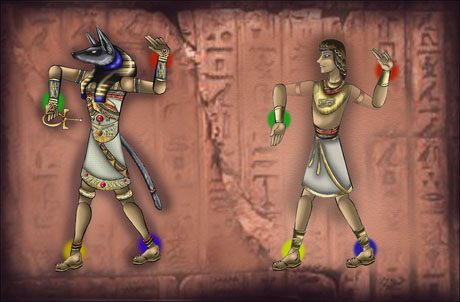 Anubis forms a rudimentary limb-pose (left), and the guest's movements are mimmicked (right). |
|||||||
| [
icehopper ] [ body cursor
] [ fogala ] [ YMCA
] [ DDA ] [ ghostbusters ]
[ EMU ] [ VEELOM ] [ DDA 2 ] |
|||||||
|
|
|||||||
| GHOSTBUSTERS | |||||||
|
Ghostbusters is the second of two hybrid prototypes which relies on both the ray-casting of Klingon UI and the virtual object tracking previously devised in Wizards&Lizards. The guest uses a markered prop to ensnare hovering spectre and slowly guide him to the trap. Duration:
2 weeks, 1 full-time dev
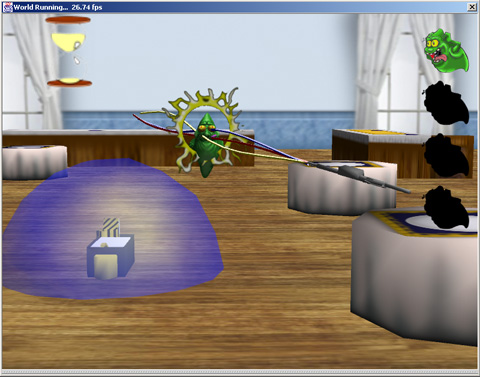 Mocap Ghostbusters in-game screenshot. |
|||||||
| [
icehopper ] [ body cursor
] [ fogala ] [ YMCA
] [ DDA ] [ ghostbusters ]
[ EMU ] [ VEELOM ] [ DDA 2 ] |
|||||||
|
|
|||||||
| MOCAP EMU | |||||||
|
Building on the well-received body cursor, our next evolution for real-time mocap was the body as a giant joystick. Using a popular Nintendo Entertainment System Emulator and some ROMs, various activities were mapped to the body on a game-by-game basis. Now, operations such as jumping in an action game are physically mapped to the feet leaving the ground in the motion capture space. Running left and right controls horizontal avatar manipulation, and a wide array of firing and launching features are bound to the movement of the arms. Although the fidelity for many of the games is not what it is with the traditional thumb-controller, it is, however, often a lot more fun (and exercise). Duration:
2 weeks, 1 part-time dev
|
|||||||
| [
icehopper ] [ body cursor
] [ fogala ] [ YMCA
] [ DDA ] [ ghostbusters ]
[ EMU ] [ VEELOM ] [ DDA 2 ] |
|||||||
|
|
|||||||
| VEELOM (MUSICAL INSTRUMENT) | |||||||
|
After experimenting with the note-based Fogala, the next step for the project was to play with the instrument's mixing capabilities, coupled with visualisations for multi-purpose feedback. The Veelom consists of a set of loops and drum patches that may be activated by moving one's hands through the motion capture space. Volume is controlled on the vertical access and loops/patches are laid out in virtual row-like arrays over the floor. The guest's hands' position is displayed on the forward-facing projection screen. The screen also serves as a menu that is manipulated by the popular body cursor in addition to allowing real-time 3D visuals. Duration:
3 weeks, 1 part-time dev
|
|
||||||
| [
icehopper ] [ body cursor
] [ fogala ] [ YMCA
] [ DDA ] [ ghostbusters ]
[ EMU ] [ VEELOM ] [ DDA 2 ] |
|||||||
|
|
|||||||
| DANCE DANCE ANUBIS 2 | |||||||
|
Continuing with the theme and functionality of the original, Dance Dance Anubis 2 moves the game into a 3D world created in LithTech Jupiter, while retaining the game's general concept and theme. A larger variety of poses were adopted that when performed in sequence, more closely emulates actual dance by the fluid movement of the guest in time. As opposed to simple pose matching, the core of DDA 2 is hitting poses on the beat in choreographed succession. Duration:
4 weeks, 3 full-time devs
|
|||||||
|
|||||||
| [
icehopper ] [ body cursor
] [ fogala ] [ YMCA
] [ DDA ] [ ghostbusters ]
[ EMU ] [ VEELOM ] [ DDA 2 ] |
|||||||
|
|
|||||||
